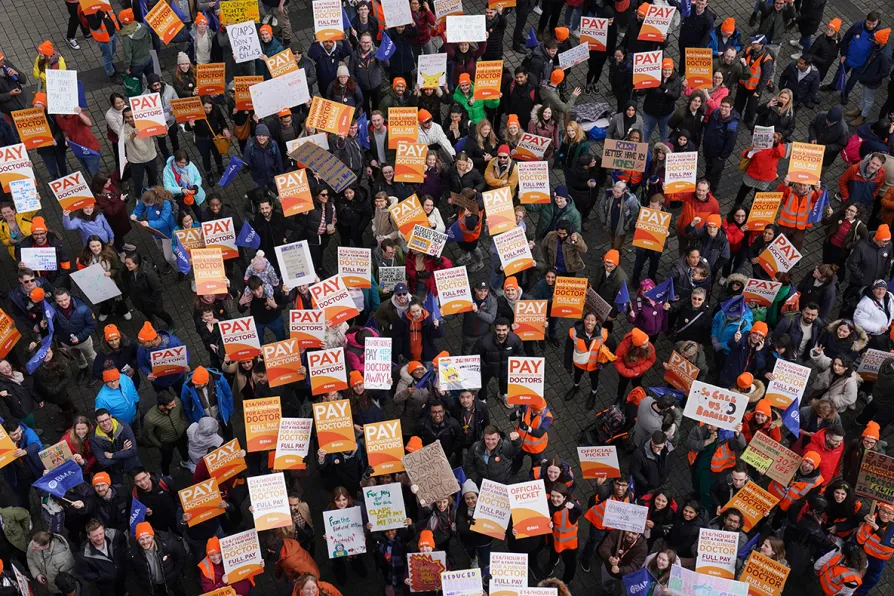
 NHS junior doctors taking part in a march and rally in the centre of Birmingham, April 2023
NHS junior doctors taking part in a march and rally in the centre of Birmingham, April 2023
JUNIOR doctors walking out for a fifth time this weekend are blamed by Tory ministers for
the NHS’s record-breaking waiting lists.
Their pay restoration demands are billed as greedy, though the case they make is straightforward, as the British Medical Association’s junior doctors committee co-chair Dr Robert Laurenson points out: “Over the last 15 years, the government has cut our pay by 31.7 per cent so we’re looking to restore that pay back to what it was like in 2008.”
Rishi Sunak declines even to discuss this — maintaining that the current offer is “fair and final,” on the grounds it has been recommended by an “independent” (by which he means government-appointed) pay review body.
Because doctors are paid more than the majority of NHS workers, whose unions have mostly either accepted the improved 6 per cent offer won through strikes earlier this year or (like the Royal College of Nursing) haven’t managed to overcome the arbitrary thresholds imposed on strike ballots since 2016, ministers hope that sympathy with their strikes will be limited.
It’s important that we counter that propaganda, and maintain support for striking doctors on picket lines.
Attempts to contrast doctors’ salaries with those of Agenda for Change workers is classic divide and rule.
It is not the case that there will be more money for anyone else if doctors’ strikes fail, as unions demonstrated earlier this year when strikes forced up the government’s public-sector pay offer across the board. Pay victories strengthen workers’ bargaining power and improve the chances of winning further pay victories.
What’s most relevant to nurses, paramedics, porters and others is not the difference between their pay and that of doctors, but the real-terms decline in pay over the past 15 years, precisely the issue the BMA continues to demand talks over. Forcing the government to concede the principle of pay restoration, even as a goal over multiple years, would be a step forward for the labour movement.
Attempts to blame industrial action for lengthening waiting lists is also insidious, because it masks the chronic staffing shortages that are really responsible.
Labour backs the Tory policy for reducing waiting lists, which is to increase NHS use of private-sector providers.
This cannot possibly work, since the private sector is parasitical on the NHS and poaches NHS staff. Commissioning more private-sector work actively worsens the NHS staffing crisis.
Our demand ultimately needs to be for more resources for the NHS. It needs more staff, it needs to pay them more and it needs to treat them better.
The Westminster consensus against raising spending needs to be challenged. It’s therefore disappointing that Scottish Labour simply carped at the Scottish National Party after research it commissioned exposed the huge funding gap between the NHS and European healthcare systems — with Germany and Norway spending a full third more per head on healthcare than we do.
Labour’s criticisms of the SNP’s record on healthcare are legitimate in themselves — but the party should prioritise the need to change the narrative and demand more money for our NHS.
Scottish Labour has left “clear red water” between it and Westminster Labour before — when in government in Holyrood it opposed the Blair government over tuition fees and prescription charges.
Devolved and regional administrations have shown a greater inclination to oppose Tory policy than Westminster Labour has — whether that’s the Scottish and Welsh government’s opposition to anti-strike laws, or mayors in northern England battling to save ticket offices.
Campaigns for proper NHS funding, and against private-sector involvement, would benefit through isolation of the pro-privatisation and pro-cuts Westminster consensus as a policy opposed by the nations and regions of Britain. We should do what we can to promote unified campaigning for the NHS, even across bitter political divides.














